Home is Where the Workout Is
Can't Make the Gym Today? Try the Living Room!
Having a gym membership is great, but sometimes it’s hard to find the time to go. Trying to balance work and family can be hard enough,
and your commitment to the gym loses priority. For the days when going to the gym simply isn’t an option, there are lots of exercises
you can do at home. Home workouts are a great supplement when you can’t fully commit to your weekly gym schedule.
Go to your kitchen and grab the following things:
- Two filled 16oz. water bottles
- Two paper plates
- A bag of flour or a gallon of milk
Wander over to the dining room and get:
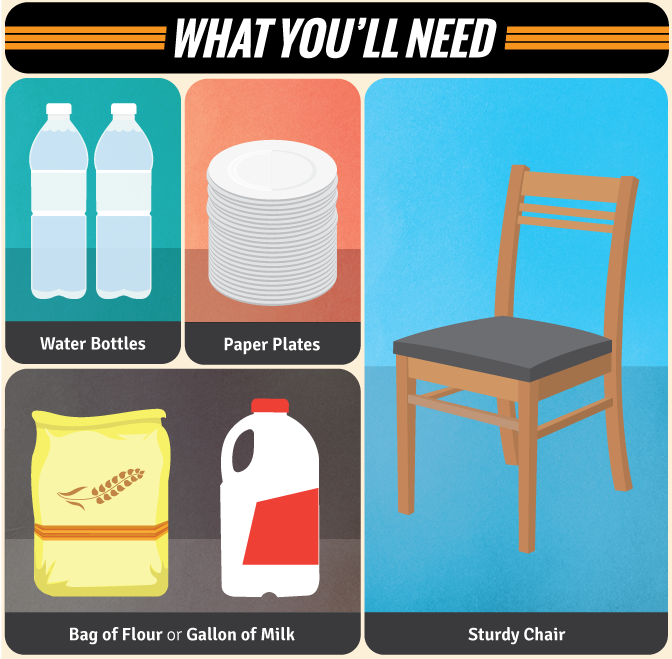
You’re ready to rock! Fancy gyms and expensive equipment are great, but you don’t need either to get a great workout.
All you need is a little creativity, your running shoes, and a couple of items you probably already have at home.
It’s always a good idea to warm up before any workout – it helps your muscles and joints get used to the full exercises
you’re about to undertake, makes certain your heart rate rises slowly rather than suddenly, and increases your core
temperature. It’s also a good idea to remember your prehab exercises to avoid a future injury!
Try to take at least eight minutes to warm up. Marching in place, gentle stretches, and a few weight-free
squats and lunges are great options.
If you have a smart phone with a stopwatch, set it for 20 minutes (otherwise, walk back to the kitchen and
set the timer on your microwave or stove for the same time). It’s now time to create your circuit!
Chair Squats
Want to tone your glutes and lower body? Take a seat! Grab your chair and make sure it’s on a sturdy surface,
where it won’t slide around. Stand in front of the chair, facing away, with your feet about hip-distance apart.
Keeping your weight in your heels, start to take a seat, pressing your glutes down and back until you’re just
about to touch the seat. But instead of sitting, hover for a few moments, making sure your knees don’t
extend past your toes, and then stand back up to your starting position.
Not tough enough? Hold one water bottle in each hand for some added weight as you squat.
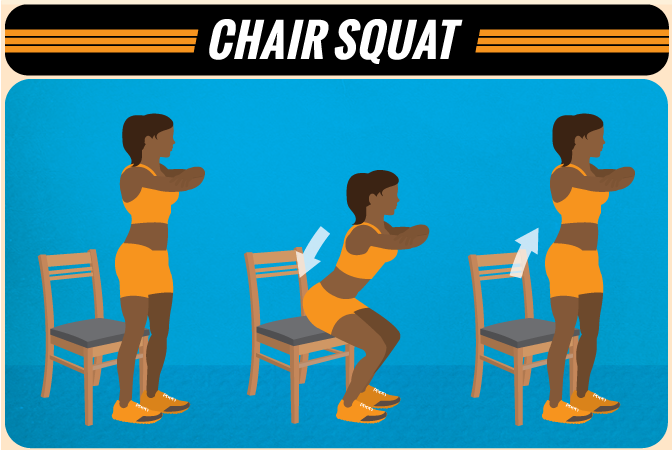
Alternative: Don’t have a chair? Try a wall sit! With your back pressed against the wall for
support, slide your glutes down toward the floor, as if you’re sitting in a chair. Inch your feet out
slowly away from the wall until your hips and knees are bent at a 90-degree angle. Keep your shoulders
against the wall, and make sure you keep your neck in a neutral extension of the spine – not looking
up or down. Hold the sit for as long as you can with good form.
Push-Ups
Ah, the push-up. Done right, it can target multiple major muscles, including your pectoralis major (chest),
rectus abdominis (abs) , erector spinae (along the spine), and depending on arm placement, the biceps and/or triceps.
Pretty good for just bodyweight, huh? For a proper push-up, whether you extend your legs or drop to your knees, it’s all
about form. Keep your hands a little wider than shoulder-width apart, and your spine neutral – no piked or sagging hips.
It helps to look at a point just ahead of your hands, rather than straight down.
To start, straighten your arms (without locking them!) and then slowly lower down, hovering when
your elbows are bent about 90 degrees. Press yourself up to the starting position,
and there’s your first push-up!
Not tough enough? Put paper plates under each hand. Lower down into your push-up hover, and as
you come back to the starting position, slide your hands in toward the center of your body.
As you drop down for the next push-up, slide your hands back to shoulder-width distance apart.
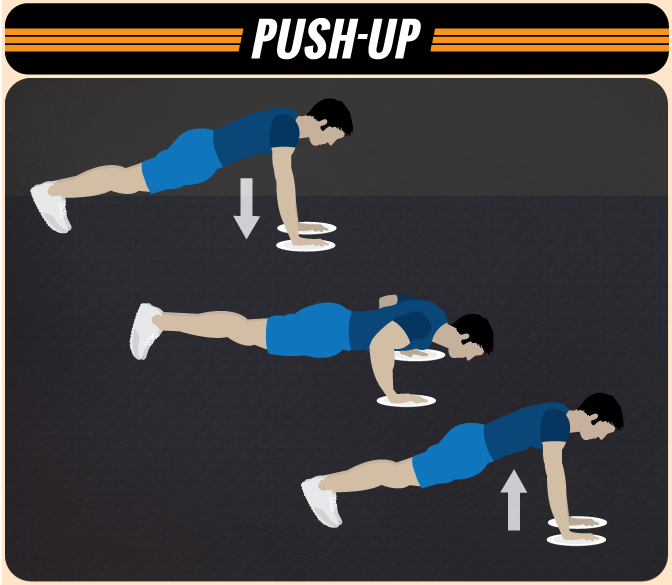
Alternative: Do push-ups against a wall. You won’t have as much body weight
resistance, and you may find it easier to complete your push-up with good form.
Reverse Fly
Taking a water bottle in each hand, with your arms relaxed by your sides, take a seat in
your chair or squat down as if you’re about to sit. Keeping your toes and heels pressed to
the floor, gently bend from the waist, bringing your chest toward the floor.
On an exhale, raise each arm to the side, until they are at or just below shoulder height.
While raising the bottles, squeeze your shoulder blades (focusing on your rhomboids ),
and then gently lower your arms to your sides.
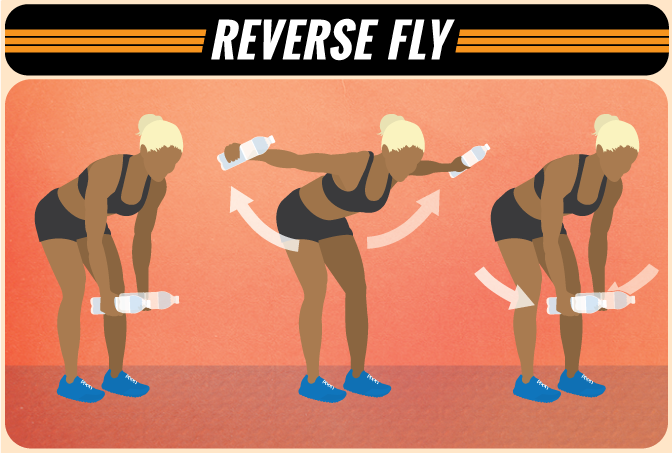
Overhead Triceps Extensions
Take a seat in your chair or stay standing – but grab your bag of flour. Engage your core and
keep your spine in neutral, and slowly raise the bag of flour over and behind your head,
with your elbows pointed straight up to the ceiling. Keeping one hand on either side of
the bag of flour, slowly lower the bag behind your neck, keeping the upper arms still.
Then slowly raise the bag over your head and move it back to your starting position.
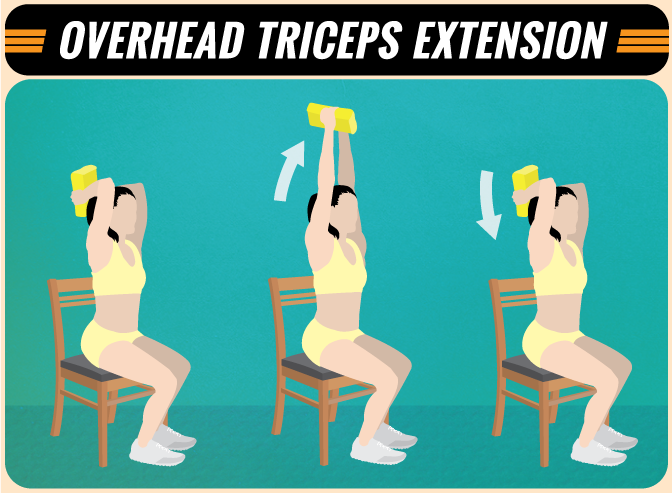
Bicycle Crunches
Laying on your back – or the supine position – lift and bend your knees until they’re at 90 degrees,
with your quadriceps perpendicular to the floor. Engaging your abs (which helps protect your spine),
gently lift your head and shoulders off the mat and bring your right knee toward your chest, rotating
slightly to bring your left elbow toward or even to your right knee. Hold for a few seconds, and then switch legs.
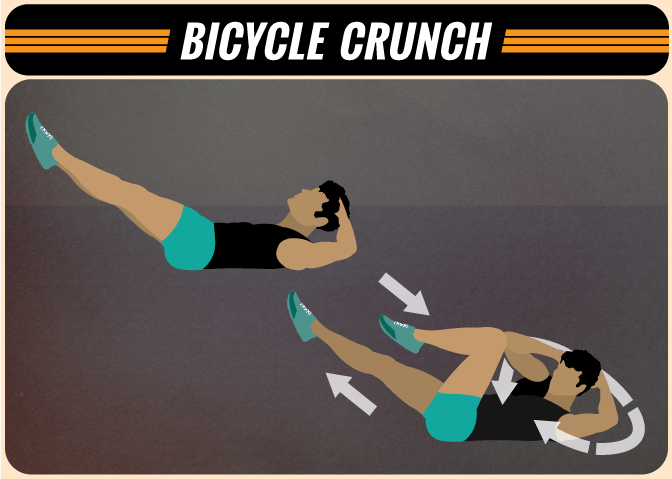
Remember to keep your movements slow and deliberate, and keep your lower back pressed into the floor.
Quite a workout, huh? Here are a few things you can add into the mix,
depending on what you can dig up in your home or garage:
- Use a jump rope (or even pretend to use one) to get a plyometric workout
- Have stairs? Use them! Walk up and down to raise your heart rate
- Use your chair as a step – put one foot on the seat and press your weight up until your second foot joins it; alternate the leading foot
There is a lot of value in joining a gym. You have access to equipment that you could never afford to have
at home, and you can connect with personal trainers, nutrition consultants, and others who can not only
determine which health goals are most appropriate for your needs, but can help make sure you meet those goals
safely. I highly recommend working with someone who can consult you on alignment and breathing techniques,
as well as suggest modifications that may be appropriate. But having home exercises like the ones I’ve
listed above can help supplement what you do at the gym – and they can be really fun, too!
Embed the article on your site

